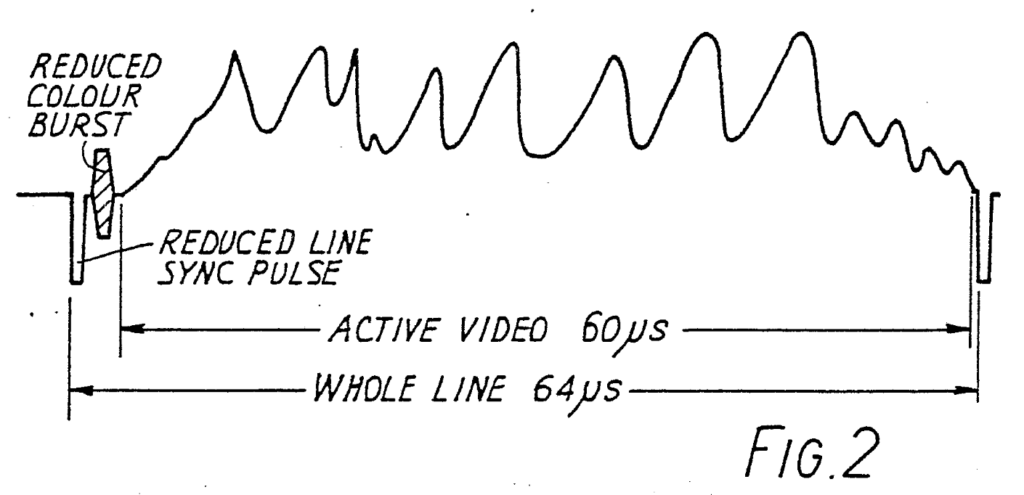The Enlarged Board of Appeal in G 1/19 considered the decision T 163/85 as an example of data intended for controlling a technical device. The following is a discussion of T 163/85 and, in the conclusion, the view of the Enlarged Board of Appeal in G1/19 is shown with respect to this decision.
General overview
European patent application No. 82 902 076.7, publication number 0 083 352, was refused by the Examining Division of the European Patent Office because of a lack of inventive step.
Subject matter of the patent application in suit
Claim 1 of the main request in the appeal proceeding:
A colour television signal adapted to generate a picture with an aspect ratio of greater than 4:3, and in which the active-video portion of a line constitutes at least 85% and preferably 90% of the line period.
Therefore, the subject matter is in regard to a colour television signal, please see the figure below (i.e. Fig. 2 of the patent application in suit):

At first sight, claim 1 does not explicitly comprise any technical device features.
In a communication, the rapporteur of the Board of Appeal objected the claim 1 in that a signal, be it a colour television signal, cannot constitute a patentable invention and that such a signal is excluded from patentability by the non-exhaustive list of exclusions summed up in Article 52(2) EPC with the proviso of Article 52(3) EPC.
According to the summary of facts and submissions of the decision, the colour television signal has the effect of improved pictures.
Reasons for the decision
Reason 2: “The Board no longer maintains its view that a claim pertaining to a colour television signal would be excluded from patentability according to Article 52(2) and (3) EPC.
As the Examining Division noted in its decision, there is no substantial difference between Claim 1 as originally filed, which was directed to a colour television system and the Claim 1 which they had to judge upon and which was directed to a colour television signal; the features of the system claim also in essence only defined a TV signal. This TV signal as now claimed is specific for the television system in which these signals occur.
[…]
However, the TV signal as claimed seems to be more than a mere presentation of information “as such”. In fact, the TV signal as claimed inherently comprises the technical features of the TV system in which it is being used and if it is considered to present information then it represents exactly that kind of information which exhibits the technical features of the system in which it occurs.
The Board considers it to be appropriate to distinguish between two kinds of information, when discussing its presentation.
According to this distinction, a TV system solely characterised by the information per se, e.g. moving pictures, modulated upon a standard TV signal, may fall under the exclusion of Article 52(2)(d) and (3) EPC but not a TV signal defined in terms which inherently comprise the technical features of the TV system in which it occurs. […]” (bold and italic letters added by the author)
Conclusion
The disputed claim 1 is in regard to a TV signal. Features of the TV system (device features) have not been claimed. Nevertheless, it has been considered by the board of appeal, that the claimed TV signal inherently comprises the technical features of the TV system.
The Enlarged Board of Appeal in G1/19 discussed this decision with respect to data intended for controlling a technical device. This data may be considered to have technical character because it has the potential to cause technical effects. In this regard, the TV signal is the data and the technical device is the TV system. The TV system is not claimed, therefore the subject matter of claim 1 (i.e. the TV signal) does not cause a technical effect but has the potential to cause a technical effect.
Definition of potential technical effect: an effect achieved only in combination with non-claimed features.
According to the Enlarged Board of Appeal in G1/19, in the context of the problem-solution approach and the COMVIK approach, such potential technical effects may be considered if the data resulting from a claimed process is specifically adapted for the purposes of its intended technical use. This is the case regarding the TV signal of claim 1 which is specifically adapted for the purpose of its intended technical use.
In such cases (with respect to the G1/19):
- either the technical effect that would result from the intended use of the data could be considered “implied” by the claim, or
- the intended use of the data (i.e. the use in connection with a technical device) could be considered to extend across substantially the whole scope of the claimed data processing method.
